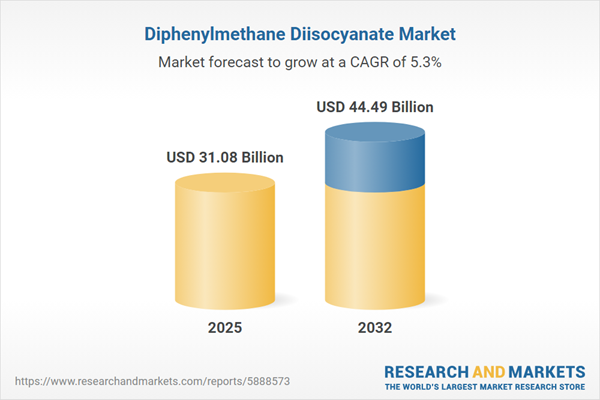Speak directly to the analyst to clarify any post sales queries you may have.
Senior executives navigating the diphenylmethane diisocyanate market require focused, actionable intelligence to keep pace with regulatory evolution, operational demands, and shifting sustainability requirements. Anticipating industry developments and managing emerging risks are central for effective leadership and sustained growth in this complex sector.
Market Snapshot: Diphenylmethane Diisocyanate Market Insights
The global diphenylmethane diisocyanate market reached a value of USD 29.54 billion in 2024 and is projected to expand to USD 31.08 billion by 2025, with further growth expected to reach USD 44.49 billion by 2032, supported by a 5.25% compound annual growth rate. Market expansion is closely linked to ongoing advances in material science and shifting international regulatory standards. Industries such as construction, automotive, and consumer products are experiencing intensified compliance requirements, which directly influence procurement choices and supply chains. As organizations adapt, they must prioritize investment in research and technological development to strengthen their market standing, respond to regulatory updates, and address evolving client needs.
Scope & Segmentation
- Application Areas: Adhesives, coatings, elastomers, rigid foams, flexible foams, and sealants dominate end-use, each segment requiring tailored technological solutions to meet compliance and optimize production efficiency in different operating environments.
- Product Types: High polymer, low polymer, and pure product variants address both established and emerging use cases. Customization across product types enables flexible responses to rapidly shifting end-user demands and supports innovative development strategies across sectors.
- Form: Crude and liquid forms offer essential adaptability for a broad range of manufacturing and specialty processes, allowing businesses to tailor operations regardless of production scale or segment.
- Distribution Channels: Direct B2B commerce, indirect network models, international distributors, system integration partnerships, and e-commerce platforms all play pivotal roles in supporting stable sourcing and responding efficiently to changing market dynamics.
- Regions Analyzed: Americas, Europe, Middle East, Africa, and Asia-Pacific display distinct regulations, growth factors, and investment trends. Companies must develop region-focused compliance and risk management strategies to drive growth and mitigate operational uncertainties.
- Leading Companies: Major industry players include Covestro AG, BASF SE, Wanhua Chemical Group, Huntsman Corporation, Dow Inc., Kumho P&B Chemicals, Tosoh Corporation, Mitsui Chemicals, Shandong Dongda Chemical, and Vencorex SAS, recognized for driving innovation and optimizing global supply chains.
Key Takeaways for Senior Decision-Makers
- Polyurethane materials derived from diphenylmethane diisocyanate provide reliable adaptability for use in sectors such as construction, automotive manufacturing, and consumer products, supporting versatility in design and function.
- The adoption of customized, low-volatile compound technologies accelerates product development and enhances compliance across regulated environments, empowering timely responses to shifting standards.
- Expanding use of bio-based feedstocks and strengthening recycling initiatives help build sustainability credentials and enable companies to align with growing stakeholder expectations.
- Integrating digital transformation throughout production and supply chain operations leads to improved transparency, real-time tracking, and greater agility when addressing sudden market changes.
- Diversifying sourcing strategies and forming resilient supplier partnerships reduce exposure to cost volatility, guaranteeing operational continuity in a fluctuating supply landscape.
- Collaboration between chemical manufacturers and equipment suppliers fosters prompt delivery of customized solutions, enabling efficient adaptation to market and operational shifts.
Tariff Impact: Navigating Emerging Complexities
Recent U.S. tariffs on diisocyanate precursors are prompting companies to reconsider supply chain strategies through reshoring and stronger reliance on established supplier networks. Industry responses include refining pricing models, broadening product portfolios, and advancing organizational agility to buffer market and regulatory challenges.
Methodology & Data Sources
This report is built on primary executive interviews within the polyurethane sector, structured industry literature reviews, and comprehensive regulatory document analysis. Expert perspectives are informed by rigorous SWOT and PESTLE frameworks, offering robust support for operational and strategic planning.
Why This Report Matters
- Supports executive decision-making for enhancing supply chain resilience and discovering new market entry points amid evolving global conditions.
- Guides partner selection, product launches, and regional expansion to sustain agility and manage risk within diverse regulatory and operational settings.
- Delivers actionable approaches to compliance and sustainability, informed by current trends and challenges unique to each major region.
Conclusion
Continuous strategic investment, technology adoption, and adaptable operations are critical for organizations across the diphenylmethane diisocyanate sector. Access to timely market intelligence equips leaders to anticipate change and seize future opportunities.
Additional Product Information:
- Purchase of this report includes 1 year online access with quarterly updates.
- This report can be updated on request. Please contact our Customer Experience team using the Ask a Question widget on our website.
Table of Contents
3. Executive Summary
4. Market Overview
7. Cumulative Impact of Artificial Intelligence 2025
Companies Mentioned
The companies profiled in this Diphenylmethane Diisocyanate market report include:- Covestro AG
- BASF SE
- Wanhua Chemical Group Co., Ltd.
- Huntsman Corporation
- Dow Inc.
- Kumho P&B Chemicals, Inc.
- Tosoh Corporation
- Mitsui Chemicals, Inc.
- Shandong Dongda Chemical Co., Ltd.
- Vencorex SAS
Table Information
| Report Attribute | Details |
|---|---|
| No. of Pages | 196 |
| Published | November 2025 |
| Forecast Period | 2025 - 2032 |
| Estimated Market Value ( USD | $ 31.08 Billion |
| Forecasted Market Value ( USD | $ 44.49 Billion |
| Compound Annual Growth Rate | 5.2% |
| Regions Covered | Global |
| No. of Companies Mentioned | 11 |









